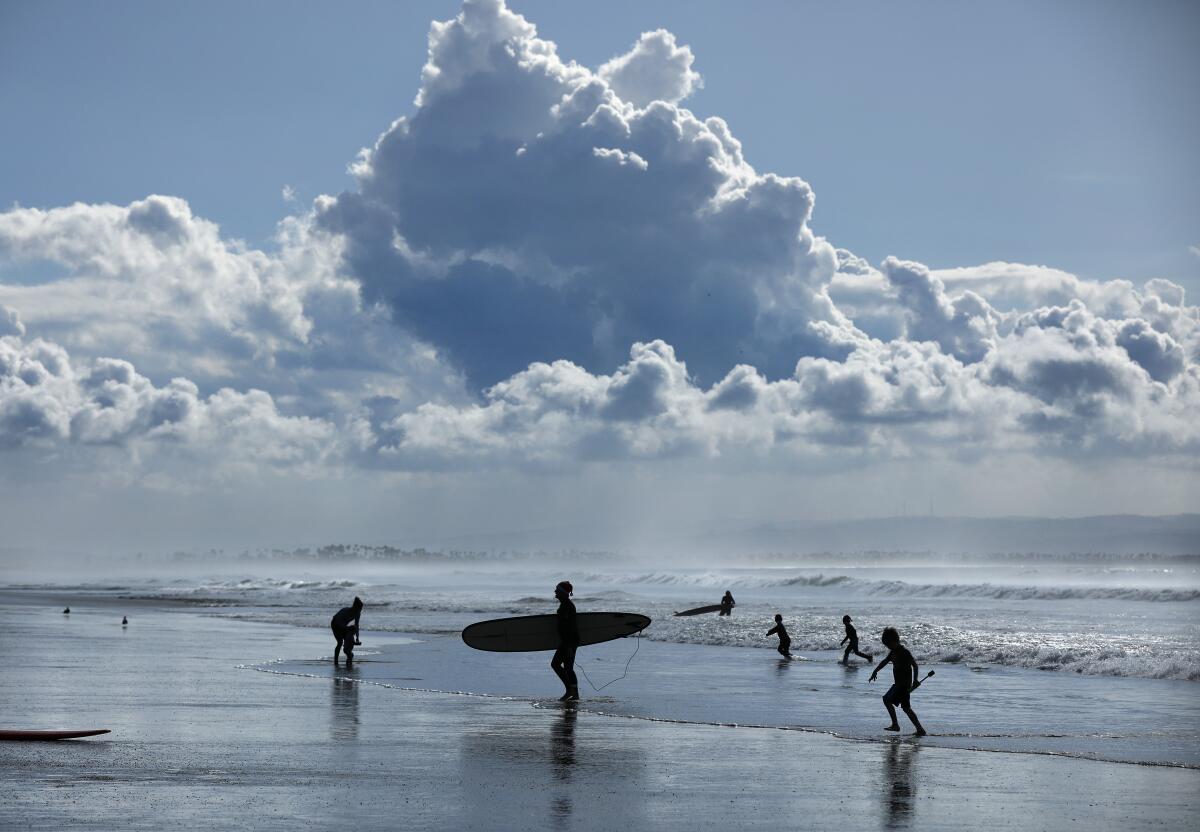Mailbag: Surfers need to step up, shed irresponsibility during pandemic

- Share via
On April 10, Huntington Beach-based Surfline.com recommended that surfers “shred at home.”
Their guidelines told their readers to follow shelter-in-place orders, and if surfing is allowed, to stay local and be as careful as possible.
“We all need to act in the most socially responsible manner possible to bring an end to this once-in-a-generation pandemic,” read Surfline’s official statement on surfing and the coronavirus.
“Surfing is no longer ethically or morally defensible,” surf historian Matt Warshaw and author of “Encyclopedia of Surfing” opined in his newsletter earlier this month. “In nonpandemic times, I will defend to the death your right to be a selfish prick of a surfer… but not now.”
Dozens of communities around the world, in Australia, Spain and Portugal, Manhattan Beach, Trestles, Laguna Beach and elsewhere, have acted, instituting bans on beach and water access that remove all ambiguity from the question.
But one Southern California community bucks the trend:
“HUNTINGTON BEACH… SOUTHERN CALIFORNIA’S LAST BASTION OF SURF FREEDOM!,” BeachGrit.com all-capped as its headline April 8.
Newport Beach continues to allow surfing, as do multiple other locations in Southern California and around the globe.
The problem with surfing now is the same as with all other kinds of compulsive, escape-the-coop activities. It allows the virus to slowly percolate and set the stage for a second wave of outbreak.
“Second waves are inevitable in pandemics when you don’t have a vaccine,” public health expert Carlos del Rio told the Wall Street Journal this month. “Any disease when you have an epidemic, when you loosen up prevention, you’ll have a second wave.”
Del Rio heads the global-health department at Emory University and was part of an advisorypanel that advised the U.S. National Collegiate Athletic Association to halt sports seasons this spring.
Visit Huntington Beach on a good-surf day. You’ll be astounded by the volume of surfers. There may be no other place in California where an outdoor activity is being pursued by similar crowds.
Photos taken on April 15 posted here show groupings of surfers reminiscent of ants converging on spilled food at Huntington Beach. Instead of charming, the images are scary and alarming.
More than 110 surfers are in the water in one April 15 image. Spanning approximately 1,500 feet of water, these surfers theoretically enjoy six feet of separation -– but only if they don’t paddle for the same wave, or narrowly miss each other while surfing, which frequently occurs.
Using epidemiological or science-based evidence to call out surfing risks -– or absence thereof -– does not yield definitive conclusions. Multiple debates have taken place, some rancorous, like one outlined April 11 in The Los Angeles times, “A beach coronavirus warning meets a tidal wave of controversy, and the test of science.”
With evidence growing on the role “silent spreaders” play, experts almost universally urge caution before relaxing distance restrictions. Not doing so could spark second waves that claim hundreds or even thousands of lives in Southern California.
One point we can make about surfers is they are among the more noncompliant of social groups. It’s no mistake that Australian sociologist and historian Mark Stranger points to “hedonistic” and “hooligan” elements in his landmark study, “Surfing Life.”
Closing beach, water and boardwalk, as other communities have done, today falls outside Huntington Beach’s action plan. Geography is one inhibitory factor. Blocking 9.5 miles of oceanfront would require an expensive law-enforcement action. It would be greeted with displeasure by many residents and perhaps viewed negatively by the Visit Huntington Beach tourism bureau and its Surf City USA marketing campaign.
In the end, or today at least, responsibility falls on the individual. Going surfing may not expose you to the virus, but it exposes the community to elevated risk.
“By going out and surfing, you’re putting the lifeguard at risk,” San Diego lifeguard James Gartland told Surfline.com this month. “And then if you end up in the hospital, you’re taking a bed away from someone who might need it more than you.”
To echo Warshaw paddling out now is the act of “a selfish prick of a surfer.” Plunging mindlessly and compulsively toward other group activities is similarly irresponsible and is behavior that needs to be contained by government authorities.
It’s up to us and responsible officials to step up and protect our communities and our most vulnerable residents.
Surfers have long endured negative stigma, a reputation they have mostly outgrown through positive contributions. Today most people around the world have friendly impressions of surfing. Let’s act now to protect those gains and good vibrations.
Erik Skindrud grew up surfing in Huntington Beach. He is publications director at the Hospital Assn. of Southern California in Los Angeles.
All the latest on Orange County from Orange County.
Get our free TimesOC newsletter.
You may occasionally receive promotional content from the Daily Pilot.





